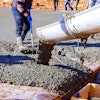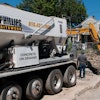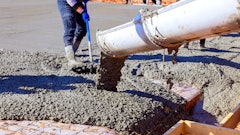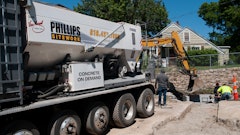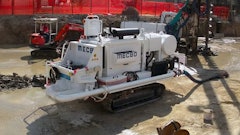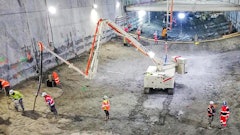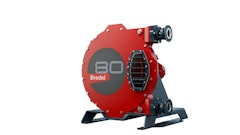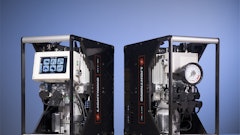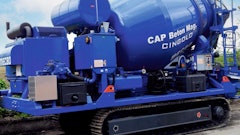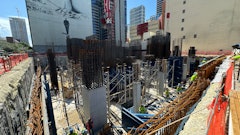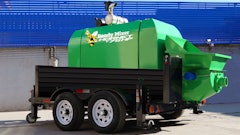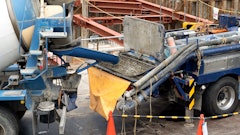Concrete contractors use line pumps instead of placing concrete directly from a ready--mix truck when they want to “reduce time, save money and have a better finished product,” according to Bryan Blankenship of CIFA USA. “Using a pump places the concrete exactly where it’s needed so it doesn’t have to be dragged with shovels and rakes,” he says. “It also keeps the concrete from segregating and keeps the aggregate well distributed. This takes less labor, which reduces cost and increases productivity.”
Another benefit of using line pumps is gaining accessibility to places where trucks can’t go. “You can’t always easily access the area where you want to place the concrete,” says Brian Cunha of Mayco Concrete Pumps. “It could be a backyard or an interior basement of a house. In areas where winter is cold, they’ll erect a building in the summer and then do the floors in the winter by pumping the concrete from the outside in.”
Selecting a Pump
When concrete contractors realize how much they’ve spent on pump rentals, they may decide to buy their own pumps. Depending on their size, small line pumps can transport to the job site on a trailer or truck.
Entry--level pumps cost about $19,000, with prices increasing up to about $60,000 for higher--volume pumps with greater pressure. One worker can operate these pumps, which typically include a remote control for regulating the concrete delivery. Hoses and other accessories also are available.
Selecting the proper pump depends a contractor’s type of work. Typical applications include shotcrete, driveways, foundations, additions to houses, block fill, footings for block walls, hillside stabilization and V ditches for diverting water. The size of the aggregate used in the mixes, how many yards of concrete are placed per hour and how far from the pump the concrete needs to go, both horizontally and vertically, also should be considered.
Basic Pump Choices
The smallest line pumps can deliver 5 yards of concrete per hour, with the largest pumps moving 60 yards per hour. Gasoline, diesel or electricity powers the engines. For most applications, diesel engines are the best choice, Cunha says, because there is no need to change spark plugs or be concerned about the fuel’s age. Because most other construction equipment runs on diesel, fuel is readily available.
“Diesel engines have an ideal torque output for pumping concrete, which is a heavy--duty application,” Cunha says. “They outlast gasoline engines. They might cost a little more, but they’re very tough.”
Schwing America offers air--cooled diesel engines with cast--iron sleeves so they can be completely rebuilt if necessary, ensuring longer machine life. “We’ve got machines still operating today on a regular basis that are more than 20 years old,” notes Tim Goodroad of Schwing.
Electric engines are best when the pump will be used inside a large or multi--story building. Magnum Pumps offers a self--propelled model small enough to fit through doorways and into elevators to get to the work site, where it is plugged in for use. This type of pump is a good choice for concrete rehabilitation on existing condominium balconies.
Smaller line pumps use mechanical ball valves to control the pumping action. Larger pumps are hydraulic, which allows them to deliver higher pressure. Magnum’s pumps use a swing tube valve, which prevents jams and air pockets.
Specialized Pump Features
“Magnum Pumps’ self--propelled models also have a concrete mixer that hooks up to them so no ready--mix truck is needed,” says Magnum’s Brian Dwyer. “If a contractor gets stuck on a job in the country, in the mountains or in a tunnel, the pump can drive itself to the site and mix up the material to be placed.”
Mayco Pumps use a very quiet liquid--cooled engine. “You can run the pump on a job site in a residential neighborhood, and people won’t complain about the noise,” Cunha says. “This also runs a forged crankshaft. These used to be three pieces welded together. This one--piece crankshaft is hammered into shape and thrown into a furnace for hardening, which increases its strength.” The pump also comes with urethane piston cups for increased durability.
Safety Matters
Concrete pump operators should wear safety gloves, steel--toe boots, safety glasses, earplugs and a long--sleeved shirt, Goodroad stresses. Quieter than larger pumps, small pumps increase operator comfort and reduce the risk of hearing damage.
Tow lights connected to the towing vehicle provide brake lights, turn signals and marker lights on Mayco Pumps for increased safety. These pumps have steel fenders so rocks and debris are not thrown onto vehicles following them.
“Schwing pumps have a hopper shutoff switch, so if you raise the hopper grate, it shuts down all the hydraulics,” Goodroad says. “We want to protect people from getting in the valve area where they can get hurt, so if they see something fall into the hopper they want to remove, when they lift the grate, everything shuts off. If you lift the water--box cover, there’s a non--removable shield in there so they can’t put their hands into the water box where the piston is moving. There are also emergency shutoff switches on both sides of the machine called E stops. There’s an E stop on the remote control. These also shut off all hydraulics so the pump cannot cycle.” Similar emergency switches are featured on all brands of pumps. Schwing’s trailers have a switch to lock up the trailer’s brakes to stop it automatically should it become disconnected from the towing vehicle.
Some pumps offered by Mayco and Magnum allow the pumping action to be reversed. This safety feature can prevent plugs. Mayco’s LS Series pumps are low--profile machines, allowing users to see the whole job site and have eye contact with other workers. In addition, the pump tows more easily because of increased rear visibility.
The Future of Concrete Pumps
Goodroad expects the use of line pumps to increase as the number of people who still use wheelbarrows and buckets to place concrete shrinks. Today’s hydraulic pumps use two sensors or proximity switches to determine the position of the pumping pistons. Cunha predicts this will increase to five or six sensors so the timing of the hydraulic valves can be varied based on the type of mix used.
“The contractor’s dream is to have the ability to do big jobs as well as small jobs with one piece of equipment so it’s never sitting in the yard idle because of the need to rent a bigger pump for a different job,” Dwyer says. He expects this to happen within the next year for concrete pumps.
Jean Feingold is a Gainesville, Florida--based freelance writer who frequently reports on concrete--related topics and other construction--industry issues.


